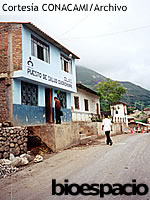The Price of the mercury
A magical remedy from the past turned a threat to our public health nowadays.
By Kathy García
The mercury word comes from the Latin voice hydrargirium that means liquid silver. That is why Hg was adopted as its chemical symbol. The Middle Age’s alchemistrians called it quicksilver or azoggeh, like it is known even today in some Andean communities of Ecuador, Peru, and Bolivia.
The
mercury exists in three forms: elementary, inorganic, and organic
(methilmercury) that has been recognized as a poison during almost 2000 years. It
was widely used like a drug until ¾ of century ago when its use was prohibited
due to toxicity in adult persons.
The
industry uses the mercury in thermometers, thermostats, barometers, batteries,
and other products. It used to use for fillings in dental amalgams, but diverse
rules worldwide have reduced or eliminated its concentration. The effects in
the human body because of an exposition to this metal are different, but the
U.S. Environmental
Protection agency alerts that
the
methilmercury can cause cancer. All types of mercury are easily absorbed by our
tissues and effectively transported by our blood.
The
life of mercury is surrounded by mysterious curative actions, magic, mysticism,
pain, tragedy, and death. The ancient civilizations as Chinese, Inca, and
Aztecan used the metallic mercury like a remedy for curing stomach’s chronic
problems. There are evidences of some places in Mexico and Peru where the
mercury is still used as a remedy.
During
hundreds of years, not realizing its poisonous and mortal power, the voodoo
Santeria used it for exorcisms and mystical power granting such as it has
detected in African-descendant communities of United States, Cuba, Haiti,
Brazil, and even Peru.
Choropampa
On
July 2nd, 2000, a Ransa’s transportation truck spread accidentaly organic
mercury in a 15-mile highway portion, mainly affecting Magdalena and Choropampa
towns, in Cajamarca Region. The mercury belonged to Minera Yanacocha, a Newmont
Mining and Buenaventura’s joint-venture with a little shareholding of the World
Bank.
The
spill’s day, some mothers hanged pieces of mercury like necklaces on their
kids’ necks for not falling ill. As a result, the children had neurologic
problems and their health deteriorated everyday.
Around
1500 people between Magdalena and Choropampa experienced chronic health
problems: headaches, blindness, skin diseases, pancreas pains, hemorrages, bone
weakening and liver’s failure, fatigue, a considerable increase of
miscarriages, nervous disorders, and breathing problems.
Consuelo
Chuqituco had a severe pain in the pancreas and refused to meet the people, she
lived with an acute depression. Enrique Cerquin was hospitalized in Lima with
malformations and tremors, uncapable to eat by his own. Rosaura Cuenca had
tumors in her feet and suffered from heavy headaches. The debunked Choropampa’s
Mayor Lot Saavedra suffered from the kidney – he was also filed for protesting
with a blockade on the Cajamarca-Lima Highway in 2001.
The
limited medical insurance paid by Yanacocha expired in December 2005 and the
future of the victims was uncertain. The mining company forced the locals to
signature compensations which released it from any further responsibility for
symptoms or health deterioration.
Comparison of poisoning symptoms in
children
Choropampa, Peru
- Lose or defficience of language.
- Social isolation, depression.
- Progressive blindness (this aspect may be cultural).
- Unconscience (faints).
- Sleeping problems.
- Behaviour problems (irritability, or much shyness)
- Apetite lose with weight lose.
- Acrodynia, legs numbness, parestesia.
- Initial signs of kidney anormality.
Previous studies
- Lost or defficient language.
- Social isolation.
- Progressive blindness.
- Unconscience (faints).
- Problems at sleep time.
- Behavior problems.
- Apetite lose with weight lose.
- Acrodynia, legs numness, parestesia.
- Initial signs of kidney anormality.
Gathered by Kathy García. Made by bioespacio for FACTORTIERRA.
Irreversible damages
The
science has concluded that although little mercury quantities may be expulsed
by urine, the most of ionic or organic mercury accumulates in the body, mainly
the brain.
Due
to its solubility (75% to 85%), it is fastly absorbed through the lungs and the
red bloodcells and the neurones, generating unrepairable neurologic damages,
cough, chest stretching, breathing problems, sick stomach, nauseas,threw ups,
diarrhea, disabled kidney drainage, delayed learning, deficient language, skin
sores, tumors, weakness, muscle malformations, paralysis, memory lose,
headaches, shyness and confidence lose, insomnia, blindness, hallucinations,
and deafness.
Mercury
levels are measured in blood, urine, and hair. Inside the blood, it can hold
for three days, so the analysis to detect it must do in an inmediate way. In Choropampa and Magdalena, the tests were
done even three weeks later when the levels in urine and blood have few
co-relation with the poisoning symptoms. This happens because the metal
impregnates fastly into the cells of the organs and freeze. That’s why
Yanacocha used this detail to minimize the massive intoxication in Cajamarca.
In
the zone, hundreds of children have learning defficiences. Rocío Guzmán’s three
kids gathered the mercury with a spoon, tasted it, carried it into home for game.Everyone
poisoned, the mother included, and stayed hospitalized for two weeks. While
healing, Rocío decided it was time to leave the town and moved to Cajamarca
City.
After
the signature of compensation agreements, Yanacocha said the case is closed and
the people was already indemnizated. In the United States and Europe, many
corporations follow to pay the treatment of thousands of people intoxicated by
mercury, while in Peru, the persons who claimed for those cases have been filed
by the government alleging terrorism instigation.
With researches by Stephanie Boyd in Piura,
Nelson Peñaherrera in Lima, and Iván Salas in Cajamarca. The newsroom in
Sullana contributed to this report.
Original versión: © 2005 Kathy García. Adapted by FACTORTIERRA, 2020.






Comentarios
Publicar un comentario